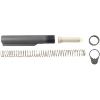texas chase
Member
I had an M4 type AR and just switched the upper to a standard govt profile 20" rifle upper. Do i need to change the buffer and/or buffer spring?
Thanks for any insight.
Chase
Thanks for any insight.
Chase
I concur, I've made this swap several times in the past and never encounter any problems. I do have H buffers in most my carbines, but I've seen them run fine with the standard carbine buffer also.A 20" rifle upper will generally work with a carbine or H buffer in a carbine tube, based on a fair bit of personal experience.
The spring should simply be the appropriate spring for the tube and buffer length you have - rifle spring for rifle tube, carbine spring for carbine tube. 99% of the time with non-SBR setups you should not get any sort of custom spring with special parameters.
The spring should simply be the appropriate spring for the tube and buffer length you have - rifle spring for rifle tube, carbine spring for carbine tube. 99% of the time with non-SBR setups you should not get any sort of custom spring with special parameters.
So if I understand this correctly, the buffer and buffer spring are really dependent on the butt stock.
I have a carbine collapsable butt stock with the original buffer and buffer spring. Say I put an A2 butt stock on it - I would want the A2 buffer and buffer spring.Is that right?
the barrel/gas system don't seem to have anything to do with the buffer/ buffer spring.(that doesn't sound exactly right...)


